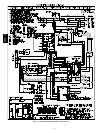
20
Two Cooling Fan Speeds Set-up (Dehumidification
feature
used)
IMPORTANT: Dehumidification control must open control
circuit on humidity rise above set point.
Use of the dehumidification cooling fan speed requires use of
either a 24 VAC dehumidistat or a thermostat which includes
control of a 24 VAC dehumidistat connection. In either case, the
dehumidification control must open the control circuit on humidity
rise above the dehumidification set point. Dehumidification
controls are available with the reverse logic; these must not be
used.
1. Using Fig. 15, move the two pin DEHUM jumper from the
“STD” position to the “DEHUM” position.
2. Remove fan speed tap wire from the “LOW” terminal on
the interface fan board (IFB) (See Fig. 15).
3. Determine correct normal cooling fan speed for unit and
application. Add the wet coil pressure drop in Table 5 to
the system static to determine the correct cooling airflow
speed in Table 4 that will deliver the nominal cooling
airflow as listed in Table 1 for each size.
NOTE: If accessory electric heat is installed, the dry
airflow must meet or exceed the minimum airflow speed
specified in Table 2 for the specific size unit. The electric
heat fan speed will be the same as the normal cooling fan
speed.
4. Remove the vinyl cap off of the desired speed tap wire
(Refer to Table 3 for color coding) for the normal cooling
fan speed and place desired speed tap wire on “HIGH” on
the interface board.
5. Refer to airflow tables (Table 4) to determine allowable
speeds for the dehumidification cooling fan speed. I n Table
4, speeds that are not allowed for dehumidification cooling
are shaded.
6. Remove the vinyl cap off of the desired speed tap wire
(Refer to Table 3 for color coding) for the dehumidification
cooling fan speed and place desired speed tap wire on the
“LOW” connection on the interface board (IFB). Verify
that static pressure is in the acceptable range for the speed
tap to be used for dehumidification cooling.
7. Use any spare vinyl plugs to cap any unused speed tap
wires.
Table 3 – ColorCoding for Indoor Fan Motor Leads
Black = High Speed
Orange = Med--High Speed
Red = Med Speed
Pink = Med--Low Speed
Blue = Low Speed
Single Speed Cooling With Higher Electric Heat Speed
This unit can also be configured to operate with single speed
cooling a nd a higher speed for an accessory electric heater.
1. Using Fig. 15, move the two pin DEHUM jumper from the
“STD” position to the “DEHUM” position.
2. See Table 2 for minimum airflow for electric heat operation.
Add electric heater and filter pressure drop to duct system
static pressure to determine total external static pressure.
3. Select speed tap from Table 4 that will achieve required
airflow from Table 2.
4. Remove the vinyl cap off of the desired speed tap wire
(Refer to Table 3 for color coding).
5. Connect the desired speed tap wire to the “HIGH” terminal
on the interface fan board (IFB).
UNIT OPERATION HAZARD
Failure to follow this caution may result in unit component
damage or improper operation.
To use this mode, a speed connection must be made on the
“HIGH” terminal that meets or exceeds the minimum
airflow found in Table 2.
!
CAUTION
ELECTRICAL SHOCK HAZARD
Failure to follow this warning could result in personal
injury or death.
Disconnect electrical power to the unit and install lockout
tag before changing blower speed.
!
WARNING
Continuous Fan Operation
When the DEHUM feature is not used, the continuous fan speed
will be the same as cooling fan speed. When the DEHUM feature
is used, the continuous fan will operate on IFB “LOW” speed
when the DH control lead is not energized, or IFB “HIGH” speed
when the DH lead is energized (see Fig. 15).
604D-- --A


















